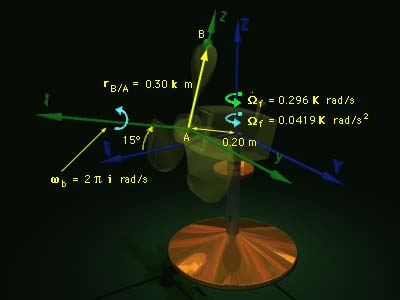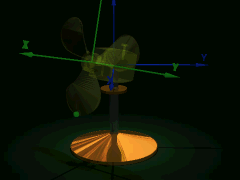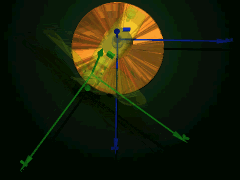| Ch 9. 3-D Motion of a Rigid Body | Multimedia Engineering Dynamics | ||||||
| Translating Coordinates | Rotating Coordinates | Inertia & Ang. Momentum |
Equations of Motion |
||||
| 3-D Motion: Rotating Coordinates | Case Intro | Theory | Case Solution |
| Chapter |
| - Particle - |
| 1. General Motion |
| 2. Force & Accel. |
| 3. Energy |
| 4. Momentum |
| - Rigid Body - |
| 5. General Motion |
| 6. Force & Accel. |
| 7. Energy |
| 8. Momentum |
| 9. 3-D Motion |
| 10. Vibrations |
| Appendix |
| Basic Math |
| Units |
| Basic Dynamics Eqs |
| Sections |
| eBooks |
| Dynamics |
| Fluids |
| Math |
| Mechanics |
| Statics |
| Thermodynamics |
| ©Kurt Gramoll |
|
|
||
|
Begin with a diagram at the instant the fly hits the uppermost blade. The stationary system XYZ is located at the center of the motor housing, the point about which the fan rotates, with the X axis parallel to the ground. |
||
 Problem Diagram |
||
|
Place the origin (Point A) of the translating- rotating system xyz at the center of the fan blades, with the x axis perpendicular to the plane of rotation of the blades. This system is rotating with the fan but not the blades. At this instant, the X and x axes are co-planar. The angular velocity and acceleration of the fan become The angular velocity and the acceleration of the fan blades are The position of B relative to A is given by rB/A = 0.30k m |
||
| Velocity |
||
|
|
The velocity of B can be broken down to its three components, Each term must be addressed separately. Term 1) Point A undergoes rotation about a fixed point, thus vA is given by vA = Ωf × rA Here, each vector is, rA = 0.2 cos15I + 0.2 sin15K vA = 0.296I × (0.2 cos15I + 0.2 sin15K) = 0.0572J m/s Term 2) Ωf × rB/A = 0.296K × 0.30k Note that: K × k = -sin15J Ωf × rB/A = -0.296 (0.30) sin15J = -0.0230J m/s Term 3) Within the xyz system, point B undergoes rotation about a fixed point: (vB/A)xyz = ωb × rB/A = 2πi × 0.30k = -1.8850j = -1.8850J Summing the terms, we get vB = -1.8510J m/s |
|
| Acceleration |
||
|
|
Use the full acceleration equation, acceleration of point B is, Again, each term must be addressed separately. Term 1) Point A undergoes rotation about a fixed point; thus, aA is = 0.0419K × (0.2 cos15I + 0.2 sin15K) + = -0.0169I + 0.0081J Term 2) = -0.0419 (0.30) sin15J = -0.0032J Term 3) = 0.296K × (-0.0230J) = 0.0068I Term 4) = 1.1159I Term 5) Within the xyz system, point B undergoes motion about a fixed point: = 0 + 2πi × (2πi × 0.30k) = -11.8435k Note that k = -sin15I + cos15K (aB/A)xyz = -11.8435 (-sin15I + cos15K) = 3.0653I - 11.4399K Summing the terms, gives aB = 4.1711I + 0.0049J - 11.4399K m/s2 |
|
Practice Homework and Test problems now available in the 'Eng Dynamics' mobile app
Includes over 400 free problems with complete detailed solutions.
Available at the Google Play Store and Apple App Store.



